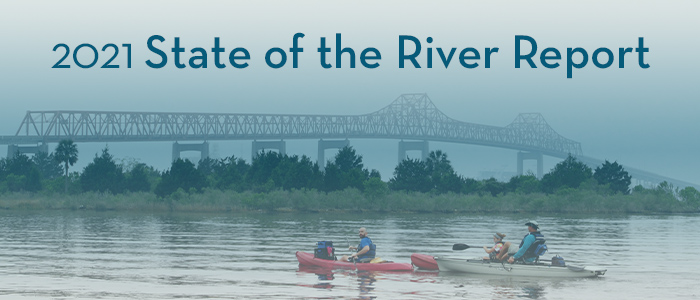The 14th annual State of the River Report for the Lower St. Johns River Basin provides significant reason for concern, while also providing a few glimpses of hope that some river health indicators may be improving.
Funded by the Jacksonville Environmental Protection Board, The State of the River Report is produced annually by scientists and researchers from Jacksonville University, the University of North Florida, Florida Southern College, and West Chester University of Pennsylvania. The report evaluates the health of the Lower Basin by assessing the current status and trends of various health indicators related to Aquatic Life, Contaminants, Fisheries, and Water Quality.
First for the good news:
- Manatee populations in the Lower St. Johns remain satisfactory. This is good news, especially considering the significant number of manatee deaths that have occurred in other parts of the state this year.
- In part due to the longstanding advocacy efforts of St. Johns Riverkeeper, total nitrogen in the mainstem of the Lower St. Johns continues to decline. Two major lawsuits involving our organization resulted in more stringent pollution standards, leading to significant reductions in nitrogen in the River over the last 15 years.
- Nitrogen in the tributaries is also improving.
- The status of most of the fish species assessed remains satisfactory, while conditions are actually improving for striped mullet, the largest fin fishery in the region.
Unfortunately, all is not well with our River. Here are some of the lowlights of the report:
- Total phosphorous in the estuary section of our river continues to worsen. That is why we have continue to advocate for tougher standards for the land application of sewage sludge, a major source of phosphorous in the St. Johns.
- We continue to see a decline in wetlands and submerged aquatic vegetation (SAV’s) due to over-development, increases in salinity, and pollution.
- Salinity levels are increasing due to sea level rise and dredging activities.
- Toxic algal blooms have persisted in the river, fueled by nutrient pollution and climate change.
- Fecal coliform bacteria levels remain high in numerous tributaries.
- Sediment contaminants remain at unsatisfactory levels. These include PCBs, organochlorine pesticides, metals, and mercury.
This year’s report also includes a new section on per- and polyfluoroalkyl substances (PFAS), an emerging contaminant. PFAS chemicals are used in a variety of products, such as water-repellent fabrics, nonstick products, and fire-fighting foams. Unfortunately, these “forever chemicals” are very persistent in the environment and in the human body since they don’t break down and can accumulate over time. According to the Environmental Protection Agency, “There is evidence that exposure to PFAS can lead to adverse human health effect.”
Recommendations from St. Johns Riverkeeper:
- Restore the natural flow of the Ocklawaha River by breaching the Rodman Dam and reuniting Silver Springs, the Ocklawaha and the St. Johns Rivers. Restoration would help offset increased salinity and improve water quality, by increasing the flow of freshwater into the St. Johns by at least 150 million gallons of water a day and restoring over 7,500 acres of forested wetlands.
- Increase funding to remove failing septic tanks and upgrade antiquated sewer infrastructure that continue to pollute our tributaries with harmful bacteria and excessive nutrients.
- Enact additional protections to prevent the further loss of Submerged Aquatic Vegetation (SAV’s) and wetlands, including the restoration of federal Clean Water Act protections for Florida wetlands.
- Reduce phosphorous pollution from the land disposal of sewage sludge by implementing more stringent regulations. Florida must also invest in more sustainable technologies to treat and manage the growing volume of human waste.
- Update Agricultural Best Management Practices (BMPs) to require compliance with water quality standards and permit requirements.
